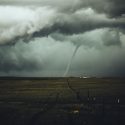Black holes aren’t exactly a popular vacation destination. They feed on anything and everything that comes into their vicinity.
They are dense, and unpredictably volatile. And they don’t let anything, and I mean anything, escape their gravitational grasp.
Going to the event horizon of a black hole would be a very daring, dangerous experience. Let’s get to it already!
Not all black holes are the same. Some of them are relatively small, reaching only 10 to 20 times the mass of our Sun. There are millions of them in the Milky Way alone.
Then there are truly gravitational giants, supermassive black holes. And they aren’t called supermassive for nothing. They can grow millions of times the mass of our Sun. And they are lurking at the center of almost every galaxy, including our own.
Choosing a black hole to travel to is the first thing you’d need to do before jumping into a spaceship. Where would you find yourself a black hole that wouldn’t gobble you up the second you arrive in its territory?
And how close could you get to one before it squeezed, and stretched, and turned you into spaghetti?
I hope you’ve seen enough What If stories by now to know that a black hole isn’t something you can see with your own eyes. What you would see is stars collapsing into it. Because black holes swallow everything they can reach with their gravity, they’re especially hard to catch on camera.
This is the first — and only — picture of a black hole we have so far. It shows the orbit of photons around a supermassive black hole in the galaxy Messier 87.
And it took eight huge telescopes across the Earth, five days of observing, and two years of combining the signals together to produce this one image. (So) Maybe, you wouldn’t need to bring your camera with you this time.
Okay, now let me pick a black hole for you. I suggest the nearest one, V616 Monocerotis, or V616 Mon. It’s only 3,000 light-years away, and has a mass that’s nine to thirteen times that of the Sun.
Now, even if you could thrust through space at the speed of light, it would still take you 3,000 years to reach V616 Mon. Our Universe is just too enormous to travel around.
That means only one thing. You’d have to jump to thousands of years into the future, when there might be the technology to get close enough to your destination.
Oh, no, it’s not time for that What If story just yet. Let’s keep heading toward V616 Mon. This is where the fun part begins!
As you’re heading towards V616 Mon, even as you’re light-years away from it, you’d start feeling the black hole’s effects. Better put your shades on.
Because while black holes don’t emit any light, they attract a lot of stars. It would be a non-stop cascade of light, and, according to Stephen Hawking, there would be radiation too.
It would also be getting quite hot. Black holes are freezing cold on the inside. Some black holes’ internal temperature could drop to only one one-millionth of a degree above absolute zero.
But on the outside, black holes have neutrino particles constantly colliding with each other, and radioactively heating their surroundings to millions of degrees. This is the part where you should be totally toasted.
But I don’t want to stop this story from getting to its destination. You’ve already traveled thousands of light-years. What’s a little heat anyway?
It didn’t stop Stephen Hawking from traveling to one of his most favorite places in the Universe — hypothetically, of course. The greatest physicist of our time toured the supermassive black hole at the center of the Milky Way.
Sorry, I forgot to mention the clouds of radiation and particles. These clouds of Hawking radiation would also be forming magnetic fields, throwing debris around at the speed of light.
How much closer could you get to the black hole? After all, you don’t want to fall into it, just visit.
Let’s see. The distance between a black hole’s event horizon and its singularity is referred to as its Schwarzschild radius, after the German physicist and astronomer Karl Schwarzschild.
The Schwarzschild radius defines the size of a black hole’s event horizon, a boundary beyond which you wouldn’t be affected by a black hole, as long as you stay on the opposite side of it. The closest you could get to a black hole, without being sucked in, would be two times the Schwarzschild radius. But if you’re looking to observe from a stable orbit, you’d better stay at a distance of three times the Schwarzschild radius.
Subscribe to What-If on YouTube or follow the show on Facebook Watch.
Sources
- “Black Holes, Explained”. 2018. nationalgeographic.com. Accessed December 28 2019.
- “What Is a Black Hole?”. 2019. NASA. Accessed December 28 2019.
- “Black Holes Were First Identified In Einstein’s General Relativity”. 2019. cosmotography.com. Accessed December 28 2019.
- “How Scientists Captured the First Image of a Black Hole – Teachable Moments | NASA/JPL Edu“. 2019. NASA/JPL Edu. Accessed December 28 2019.
- “Diving Into A Black Hole”. 2018. INSH. Accessed December 28 2019.
- “Where is the closest black hole?”. Fraser Cain, 2019. phys.org. Accessed December 28 2019.
- “Five Reasons You Wouldn’t Want to Live Near a Black Hole”. GSFC, By Kelly. 2019. Exoplanet Exploration: Planets Beyond Our Solar System. Accessed December 28 2019.
- “Are black holes hot or cold?”. Fisher, Len. 2019. BBC Science Focus Magazine. Accessed December 28 2019.
- “How Close Can You Orbit A Black Hole?”. 2019. youtube.com. Accessed December 28 2019.
- “Black Holes Might Cause Spaghettification”. Ashley Hamer, 2019. curiosity.com. Accessed December 28 2019.



























